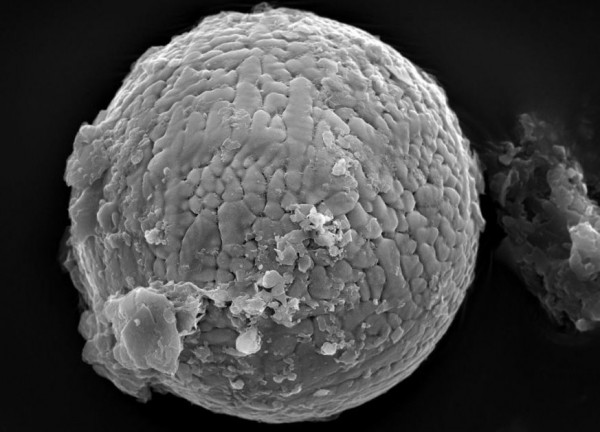Oldest Meteorites Discovered Upend Theories about Habitability of Early Earth
| Arthur Dominic Villasanta | | May 11, 2016 10:22 PM EDT |
(Photo : Andrew Tomkins) One of the oldest micrometeorites yet discovered on Earth
A bunch of 60 micrometeorites discovered embedded in limestone in Australia have a value far beyond their being the oldest micrometeorites ever found. Scientists now say these 2.7 billion year-old spheres the size of dust grains challenge prevailing theories about the oxygen content of early Earth's atmosphere.
Like Us on Facebook
In addition, this discovery also stands to impact the parameters in the search for extraterrestrial life that rely a lot on the amount of oxygen present in the atmosphere of exoplanets.
The conventional wisdom is the Earth had no oxygen in its atmosphere before 2.3 to 2.4 billion years ago. Scientists agree the Earth before 2.5 billion years ago had an atmospheric oxygen level less than 0.001 percent that of today's.
At that early time, the Earth hadn't been flooded by the oxygen created by plants and algae as a byproduct of photosynthesis. This atmospheric revolution occurred some 2.5 to 2.4 billion years ago and is known as the "Great Oxidation Event."
Analysis of these 60 micrometeorites disputes this theory in a big way.
As explained by Andrew Tomkins, a geologist at Monash University in Melbourne, Australia, the chemical makeup of the Earth's atmosphere 2.7 billion years ago would have affected how the micrometeorites melted and what molecules the cooling meteorites formed.
Scientists can, therefore, use these micrometeorites to deduce the composition of the atmosphere at the time since they know micrometeorites melt and quench-cool about two seconds after they start burning as they enter the Earth's atmosphere.
Tomkins discovered these micrometeorites traveled though an atmosphere that was some 20 percent oxygen. He and his team came to this stunning conclusion by studying the exact composition of meteorites' metal oxides.
An atmosphere that was 20 percent oxygen is only possible if the far reaches of the upper atmosphere some 50 to 100 kilometers above the surface were inundated by oxygen. In contrast, the lower atmosphere was almost certainly devoid of oxygen, said Tomkins.
Oxygen in the upper atmosphere would have been formed by ultraviolet light from the sun splitting water vapor and carbon dioxide.
Tomkin's findings, however, create a massive conundrum for astronomers and planetary scientists.
If the Earth's upper atmosphere in the past did indeed have massive amounts of oxygen (a condition necessary to evolve and sustain life) then the atmospheres of the many exoplanets being discovered could appear more oxygen-rich than they actually are. This, in turn, will lead to misleading conclusions about the habitability of these exoplanets.
Tagsmicrometeorites, atmosphere, Andrew Tomkins, Monash University, Oxygen, Exoplanets
©2015 Chinatopix All rights reserved. Do not reproduce without permission
EDITOR'S PICKS
-

Did the Trump administration just announce plans for a trade war with ‘hostile’ China and Russia?
-

US Senate passes Taiwan travel bill slammed by China
-

As Yan Sihong’s family grieves, here are other Chinese students who went missing abroad. Some have never been found
-

Beijing blasts Western critics who ‘smear China’ with the term sharp power
-

China Envoy Seeks to Defuse Tensions With U.S. as a Trade War Brews
-

Singapore's Deputy PM Provides Bitcoin Vote of Confidence Amid China's Blanket Bans
-

China warns investors over risks in overseas virtual currency trading
-

Chinese government most trustworthy: survey
-

Kashima Antlers On Course For Back-To-Back Titles
MOST POPULAR
LATEST NEWS
Zhou Yongkang: China's Former Security Chief Sentenced to Life in Prison

China's former Chief of the Ministry of Public Security, Zhou Yongkang, has been given a life sentence after he was found guilty of abusing his office, bribery and deliberately ... Full Article
TRENDING STORY

China Pork Prices Expected to Stabilize As The Supplies Recover

Elephone P9000 Smartphone is now on Sale on Amazon India

There's a Big Chance Cliffhangers Won't Still Be Resolved When Grey's Anatomy Season 13 Returns

Supreme Court Ruled on Samsung vs Apple Dispute for Patent Infringement

Microsoft Surface Pro 5 Rumors and Release Date: What is the Latest?












